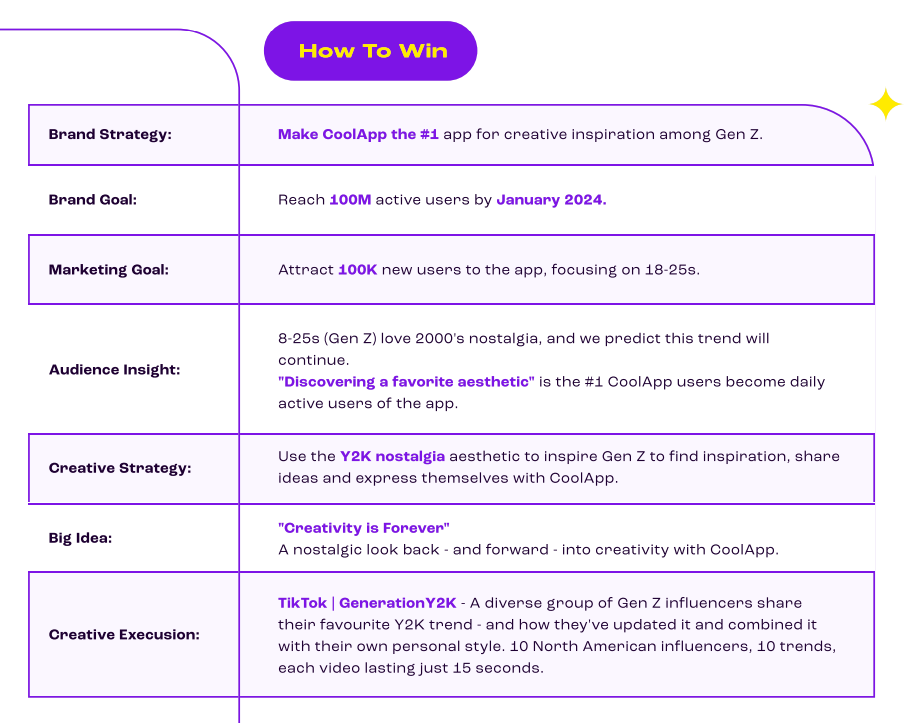The Ultimate Guide to Creative Strategies at Scale | Smartly.io
Branding
What Is a Creative Strategy?

A creative strategy serves as an enduring plan guiding the utilization of creative assets to attain business objectives for your brand.
It is crucial that your creative strategy establishes a clear connection between your brand’s direction, and communication with the audience, and consistently aligns with your brand values.
It is common for people to mistakenly interchange creative strategy with brand strategy; however, it is essential to recognize the distinction.
While a brand strategy encompasses your comprehensive vision for the destination of your brand and business, a creative strategy specifically outlines the blueprint for bringing that vision to fruition.

What Makes a Good Creative Strategy?
Crafting a Creative Strategy involves synthesizing insights and brand identity into a well-defined directive for your creative team.
Investing time in developing a meticulous creative strategy is essential to ensure your creative endeavors’ effectiveness and enduring relevance, aligning them with your brand’s identity and long-term objectives.

Channel Agnosticism is a key aspect of a creative strategy, allowing for a universal theme and approach that accommodates diverse creative expressions across ideas, execution, and channels. Recognizing that each channel has its demands and influences distinct audience behaviors, particularly on social media, collaboration with the channel is emphasized.
Insight-driven creativity is crucial, with a great creative strategy rooted in true and surprising insights that provide a glimpse into the audience’s mindset. Conducting audience research and employing the empathetic approach of design thinking, understanding audience behaviors, feelings, and values is emphasized.
A testable approach is advocated, encouraging an iterative mindset where creative work is never truly finished. The creative strategy should provide flexibility to test various approaches, encompassing messaging, channels, and formats. Furthermore, the strategy should extend beyond a single campaign, defining a creative era for the brand.
Customizability is underscored, proposing a simple framework that starts with the brand strategy and cascades down to the business goal, and marketing goal. Eventually, it forms a creative strategy shaping the “Big Idea.” This adaptable framework enables the creative team to develop diverse ideas tailored to specific channels without being overly prescriptive.
The Creative Strategy serves as a springboard for the creative team, offering a point of view without rigid prescriptions. It encourages the development of a variety of ideas that can be translated into channel-specific executions.
The Winning Framework emphasizes the need to address diverse audience segments personally, encouraging creative teams to interpret the creative strategy in a way that aligns with modular design principles. This involves shaping the strategy to suit different sub-audiences, regions, languages, and product lines for maximum relevance and relatability.

Evergreen Principles of Creative Design
It is equally crucial to uphold the foundational principles of creativity as it is to stay abreast of current trends. Profound creativity is rooted in enduring principles that have withstood the test of time. Let’s explore a few of these fundamental principles, particularly the seven design principles:
- Emphasis: Ensure that your designs feature a pertinent focal point, capturing the viewer’s attention swiftly. This is especially critical for social media ads, where you have a brief moment to engage the audience.
- Balance and Alignment: Deliberate on the weight and positioning of text and visuals during the creation of your ads, crafting designs that are visually appealing and cohesive.
- Contrast: When constructing designs, ensure a clear separation of elements like text and content to guide the viewer’s focus to specific aspects.
- Repetition: Explore ways to repeat visual patterns, sound cues, and video cuts, establishing a rhythmic quality in your content. This repetition reinforces your message, making it more memorable.
- Proportion: Contemplate how you group elements in your designs to create a collective weight. Proportion results from achieving a harmonious balance, alignment, and contrast, unifying your design seamlessly.
- Movement: Vital for both static designs and dynamic content, movement involves orchestrating elements to maintain viewer attention throughout. Each element should seamlessly lead into the next, constructing a simple narrative irrespective of format.
- White Space: Consider the negative spaces within your design. What you intentionally omit from your design is as significant as the included details, as the absence accentuates the positive elements. This thoughtful use of white space enhances the overall impact of your design.
The Table of Contents of “The Ultimate Guide to Creative Strategies at Scale”:
- What Is a Creative Strategy?
- Evergreen Principles of Creative Design
- Formats for Each Stage of The Funnel
- Remember the These Creative Rules
Number of Pages:
- 20 pages
Pricing:
- Free
Warning: Undefined array key "sidebar_ads" in /home/dmc/public_html/wp-content/themes/DMC/functions/helpers.php on line 824






